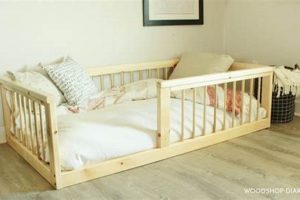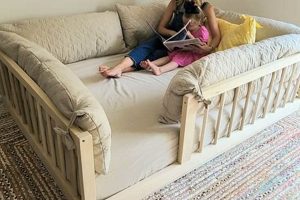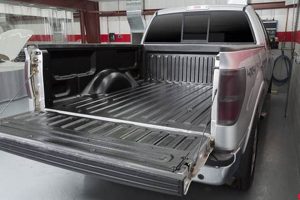The construction of bicycle transport solutions for pickup trucks, undertaken by individuals, involves creating a system within the truck bed to securely hold and stabilize bicycles during transit. This process can range from simple securing methods utilizing readily available materials to more complex, fabricated structures designed for specific bicycle types and truck bed dimensions. Examples include using lumber to create wheel chocks or modifying existing cargo management systems to accommodate bicycle frames.
This approach to bicycle transportation offers potential cost savings compared to commercially available carriers. It allows for customization tailored to the specific needs of the user and their equipment, accommodating unique bicycle geometries or multiple bicycles. Historically, individuals have adapted vehicles for cargo transport, demonstrating resourcefulness and problem-solving skills. This do-it-yourself approach continues this tradition, offering an alternative to mass-produced solutions.
The following sections will explore various design considerations, material options, and construction techniques applicable to developing a custom bicycle carrying system for a pickup truck bed, emphasizing safety and security.
Essential Considerations for Homemade Truck Bed Bike Carriers
Constructing a secure and reliable bicycle carrier within a truck bed necessitates careful planning and execution. The following tips offer guidance to ensure safety and prevent damage during transport.
Tip 1: Secure Attachment Points: Prioritize the use of robust attachment points within the truck bed. Factory-installed tie-down points or aftermarket bed rails provide secure locations for anchoring the carrier structure. Avoid relying solely on the truck bed’s plastic lining for anchoring, as it may not withstand significant stress.
Tip 2: Bicycle Frame Protection: Implement measures to prevent abrasion and damage to the bicycle frame. Padding contact points between the bicycle and the carrier is crucial. Closed-cell foam or rubberized coatings can minimize friction and prevent scratches.
Tip 3: Wheel Security: Ensure bicycle wheels are adequately secured to prevent movement during transit. Wheel chocks constructed from wood or metal provide stability. Straps or bungee cords should supplement the chocks, not replace them, to prevent wheel dislodgement.
Tip 4: Material Selection: Choose durable and weather-resistant materials for carrier construction. Pressure-treated lumber, steel, or aluminum offer appropriate strength and longevity. Consider the climate the carrier will be exposed to and select materials accordingly to prevent corrosion or warping.
Tip 5: Weight Distribution: Distribute the weight of the bicycle(s) evenly across the truck bed. Concentrated weight in one area can compromise the truck’s handling and stability. Position bicycles strategically to maintain a balanced load.
Tip 6: Regular Inspection: Conduct routine inspections of the carrier and its attachment points. Check for signs of wear, loosening, or damage. Address any issues promptly to prevent potential failures during transit.
These considerations prioritize the secure and damage-free transport of bicycles within a truck bed, enhancing safety and protecting valuable equipment.
The subsequent sections will delve into specific design examples and address common challenges encountered during construction.
1. Stability
Stability is a fundamental requirement in truck bed bicycle carrier designs undertaken by individuals. A lack of stability during transport leads to potential damage to the bicycles, the truck bed, and creates a significant safety hazard for other drivers. The inherent motion of a vehicle, including acceleration, braking, and turning, exerts forces on the bicycles secured within the truck bed. A carrier lacking adequate stability allows for excessive movement, resulting in impacts, abrasion, and potential structural failure of the carrier itself.
Consider, for example, a wooden carrier constructed without sufficient bracing or securement to the truck bed. During a sudden braking maneuver, the bicycles could shift forward, potentially impacting the cab of the truck or even dislodging from the carrier entirely. In a real-world scenario, this could cause significant damage to the bicycles and pose a serious risk to following vehicles. Achieving stability necessitates careful consideration of load distribution, appropriate material selection, and secure attachment methods. Designs often incorporate wheel chocks, frame supports, and tie-down straps to minimize movement in all directions. The effectiveness of these elements directly correlates to the overall stability of the system.
In summary, stability is not merely a desirable attribute, but a non-negotiable design parameter for any homemade truck bed bicycle carrier. Without a focus on robust stability, the potential for damage and safety risks becomes unacceptably high. Addressing this concern directly through careful planning and execution is essential for creating a functional and safe bicycle transport solution.
2. Attachment
Secure attachment is paramount in the context of do-it-yourself bicycle carriers for truck beds. The effectiveness of the carrier hinges on its ability to remain firmly affixed to the truck bed, preventing movement or separation during transit. Failure to ensure adequate attachment can result in damage to the bicycles, the truck bed, or create a hazard for other vehicles.
- Anchor Point Integrity
The structural integrity of the chosen anchor points within the truck bed directly influences the security of the attachment. Utilizing factory-installed tie-down points, bed rails, or aftermarket anchoring systems provides a more reliable foundation than relying solely on the truck bed’s sheet metal or plastic liner. Compromised anchor points can lead to carrier detachment under stress, particularly during sudden braking or sharp turns. The selection and condition of these points is a critical consideration.
- Fastener Selection
Appropriate fastener selection is essential for creating a robust connection between the carrier and the anchor points. Bolts, screws, or straps must be appropriately rated for the anticipated load and environmental conditions. Corrosion-resistant materials are preferable to prevent weakening of the connection over time. Under-specifying fasteners can lead to failure under stress, while over-tightening can damage the anchor points or the carrier structure.
- Connection Method
The method of connecting the carrier to the anchor points significantly affects the overall security of the system. Direct bolting provides a rigid connection, minimizing movement. However, it may require drilling and can be less adaptable. Straps offer greater flexibility but require careful selection of load ratings and regular inspection for wear. A poorly executed connection method can introduce weak points in the system, increasing the risk of detachment.
- Redundancy
Implementing redundancy in the attachment system enhances overall safety. Utilizing multiple attachment points distributes the load and provides a backup in case of failure at a single point. This redundancy can be achieved through the use of multiple straps, bolts, or a combination of connection methods. Redundancy adds a layer of security, mitigating the consequences of a single point of failure.
The aforementioned elements are inextricably linked to the safety and reliability of a do-it-yourself truck bed bicycle carrier. Each facet contributes to the overall security of the attachment, and neglecting any one aspect can compromise the entire system. Prioritizing robust attachment methods is paramount to ensuring the safe transport of bicycles within a truck bed.
3. Protection
The correlation between protection and truck bed bike carrier projects undertaken by individuals centers on safeguarding bicycles from damage during transportation. The open environment of a truck bed exposes bicycles to various hazards, including impacts from other cargo, abrasion from the truck bed surface, and weather-related damage. A properly designed and constructed carrier mitigates these risks, ensuring the bicycle arrives at its destination in optimal condition. For instance, a simple homemade carrier using only tie-down straps without adequate padding or frame support can lead to scratches, dents, or even structural damage to the bicycle frame during a bumpy ride. Conversely, a carrier incorporating padded contact points, secure wheel chocks, and a robust frame support system significantly reduces the likelihood of damage.
Effective protection extends beyond preventing physical damage. It also involves shielding bicycles from environmental factors. Exposure to rain, snow, and direct sunlight can degrade bicycle components over time. A carrier incorporating a protective cover or constructed from weather-resistant materials minimizes these effects. Furthermore, theft prevention falls under the umbrella of protection. A secure carrier design that incorporates locking mechanisms or conceals the bicycles from view deters potential theft, adding another layer of protection beyond preventing physical harm. Consider the case of a mountain biker transporting an expensive bicycle to a trailhead; a carrier offering both physical and theft protection is essential for safeguarding their investment and ensuring a worry-free trip.
In summation, the concept of protection is integral to any truck bed bicycle carrying system, especially those constructed by individuals. It encompasses a multifaceted approach, addressing physical damage, environmental exposure, and theft prevention. A well-designed carrier prioritizes these aspects, ensuring the bicycle’s integrity and providing peace of mind to the owner during transportation. The inherent challenges lie in balancing cost-effectiveness, ease of construction, and the level of protection afforded by the design, necessitating careful consideration of individual needs and risk assessment.
4. Material
The selection of appropriate materials represents a cornerstone of successful do-it-yourself truck bed bicycle carrier construction. The structural integrity, longevity, and overall safety of the carrier are directly influenced by the materials chosen. For instance, utilizing untreated lumber in a region with frequent rainfall can lead to rapid deterioration, compromising the carrier’s strength and stability. Conversely, selecting a high-strength steel alloy, while providing superior durability, might introduce unnecessary weight and complexity into the fabrication process. Therefore, the material selection process requires a careful evaluation of factors such as load-bearing capacity, resistance to environmental elements, ease of workability, and cost-effectiveness.
The impact of material choice extends beyond structural considerations. The material’s surface properties affect the protection afforded to the bicycles being transported. Using bare metal for contact points can result in abrasion and damage to bicycle frames. Implementing cushioning materials, such as closed-cell foam or rubber coatings, mitigates this risk. Furthermore, the material’s aesthetic qualities influence the overall appearance of the carrier. A well-constructed carrier utilizing aesthetically pleasing materials can enhance the overall impression of the vehicle. Practical application involves carefully considering the weight limitations of the truck bed, the type of bicycles being transported, and the intended usage environment. A mountain biker transporting heavy bicycles in rugged terrain would require a more robust material selection compared to an individual transporting lightweight road bicycles on paved surfaces.
In conclusion, the connection between material selection and do-it-yourself truck bed bicycle carrier construction is undeniable. The appropriate material choice directly impacts the carrier’s structural integrity, longevity, bicycle protection capabilities, and overall aesthetic appeal. The challenges lie in balancing cost considerations with performance requirements and carefully evaluating the environmental factors the carrier will be exposed to. Ultimately, a well-informed material selection process is crucial for creating a safe, reliable, and functional bicycle transport solution.
5. Compatibility
The successful implementation of do-it-yourself truck bed bicycle carriers hinges significantly on compatibility. This concept encompasses the alignment between the carrier design, the specific truck bed dimensions, and the characteristics of the bicycles intended for transport. A mismatch in any of these areas can render the carrier ineffective, unsafe, or even unusable.
- Truck Bed Dimensions
The physical dimensions of the truck bed constitute a primary compatibility factor. Bed length, width, and depth dictate the maximum size and configuration of the carrier. Designs must account for wheel well protrusions, bed liner thickness, and the location of existing tie-down points. A carrier built for a long-bed truck may not fit within a short-bed, and vice versa. Measurements should be precise to avoid dimensional conflicts during installation and use.
- Bicycle Type and Geometry
Different bicycle types possess varying frame geometries, wheel sizes, and handlebar widths. A carrier designed solely for road bikes may not accommodate mountain bikes with wider tires and longer wheelbases. Similarly, e-bikes often have heavier frames and different mounting requirements compared to traditional bicycles. The carrier design must consider the specific characteristics of the bicycles intended for transport to ensure a secure and stable fit.
- Attachment Point Location and Strength
The location and load-bearing capacity of existing truck bed tie-down points influence the carrier’s attachment strategy. If tie-down points are sparse or weakly constructed, the carrier design must compensate with alternative anchoring methods or reinforced support structures. The carrier should distribute the load evenly across multiple attachment points to prevent localized stress and potential failure. Compatibility with existing attachment infrastructure is crucial for a secure and reliable connection.
- Ease of Loading and Unloading
Compatibility also extends to the practical aspects of loading and unloading bicycles. The carrier design should facilitate easy access to the bicycles without requiring excessive lifting or maneuvering. Low-profile designs or integrated ramps can simplify the loading process, particularly for heavier bicycles. A user-friendly design enhances the overall convenience and reduces the risk of injury during bicycle transport.
These facets of compatibility are inextricably linked within the context of do-it-yourself truck bed bicycle carriers. A carrier design that fails to adequately address these considerations is likely to be ineffective, unsafe, or impractical. A comprehensive assessment of truck bed dimensions, bicycle characteristics, attachment point availability, and ease of use is essential for creating a successful and functional bicycle transport solution.
6. Security
Security, in the context of individuals constructing bicycle carriers for truck beds, pertains to measures taken to prevent theft and ensure the bicycle remains firmly affixed during transport. A lapse in security can result in the loss of valuable property and create hazardous conditions for other motorists.
- Locking Mechanisms
The integration of locking mechanisms into the carrier design is crucial for theft deterrence. Cable locks, U-locks, or integrated locking systems secure the bicycle frame to the carrier, preventing unauthorized removal. The effectiveness of these mechanisms depends on the quality of the locking hardware and the strategic placement within the carrier structure. Example: A steel cable threaded through the bicycle frame and secured to a locking point on the carrier prevents opportunistic theft during brief stops.
- Concealment Strategies
Concealing the bicycles from view reduces the likelihood of attracting potential thieves. Carrier designs that incorporate covers or enclosures obscure the bicycles, making them less visible and therefore less appealing targets. The effectiveness of concealment depends on the degree of visual obstruction and the overall design of the carrier. Example: A tonneau cover extending over the truck bed and concealing the bicycles from view minimizes the risk of theft in high-crime areas.
- Attachment Redundancy
Redundant attachment systems enhance security by providing multiple points of securement between the bicycle and the carrier, and between the carrier and the truck bed. This redundancy ensures that even if one attachment point fails or is compromised, the bicycle remains firmly in place. Example: Utilizing both wheel chocks and tie-down straps to secure the bicycle wheels prevents movement and reduces the risk of dislodgement during transit.
- Tamper-Resistant Hardware
The use of tamper-resistant hardware, such as security bolts or specialized fasteners, deters attempts to dismantle the carrier or remove the bicycles without specialized tools. These fasteners increase the difficulty of unauthorized access, making the carrier a less attractive target for thieves. Example: Replacing standard bolts with tamper-proof bolts on critical carrier components prevents easy removal with common tools.
These security facets are interconnected and contribute to the overall protection of bicycles transported in truck beds using do-it-yourself carriers. A comprehensive approach to security, incorporating locking mechanisms, concealment strategies, attachment redundancy, and tamper-resistant hardware, minimizes the risk of theft and ensures the safe transport of valuable bicycles.
Frequently Asked Questions
This section addresses common inquiries regarding the construction of bicycle carriers for truck beds, undertaken by individuals. It aims to provide clarity on key aspects, promoting safety and informed decision-making.
Question 1: What is the minimum skill level required to construct a safe and reliable bicycle carrier for a truck bed?
The construction of a safe and reliable bicycle carrier necessitates a moderate level of skill in woodworking or metalworking, depending on the chosen materials. Familiarity with basic tools, accurate measurement techniques, and structural principles is essential. Individuals lacking such skills should seek guidance from experienced builders or consider alternative solutions.
Question 2: What are the primary safety considerations when designing and building a truck bed bike carrier?
Primary safety considerations include secure attachment to the truck bed, adequate bicycle frame support, wheel stability, and protection against abrasion. The carrier must withstand the forces exerted during acceleration, braking, and turning. Regular inspection and maintenance are crucial to ensure ongoing safety.
Question 3: What materials are best suited for constructing a durable and weather-resistant truck bed bike carrier?
Pressure-treated lumber, steel, and aluminum are commonly used materials. Pressure-treated lumber offers cost-effectiveness and ease of workability, while steel provides superior strength. Aluminum offers a balance of strength and weight reduction, but may require specialized welding techniques. The choice depends on budget, skill level, and desired durability.
Question 4: How can one ensure that a homemade truck bed bike carrier complies with relevant safety regulations?
Currently, no specific regulations govern the construction of homemade bicycle carriers for truck beds. However, it is prudent to adhere to general safety principles, such as ensuring secure attachment, preventing obstruction of visibility, and avoiding sharp edges or protrusions. Consulting with transportation authorities or safety experts is recommended.
Question 5: What are the potential risks associated with using a poorly constructed truck bed bike carrier?
A poorly constructed carrier can lead to bicycle damage, truck bed damage, or, in severe cases, create a road hazard. Bicycles may become dislodged during transit, posing a risk to other vehicles. Structural failure of the carrier can also result in injury to the operator or bystanders.
Question 6: How frequently should a homemade truck bed bike carrier be inspected for wear and tear?
A thorough inspection should be conducted before each use, focusing on attachment points, structural integrity, and the condition of securing straps or hardware. More comprehensive inspections should be performed monthly or after prolonged use, addressing any signs of wear, corrosion, or damage.
These FAQs provide essential insights into the process of building bicycle carriers for truck beds. Adhering to these principles promotes a safe and reliable outcome.
The subsequent section will explore design variations and practical construction tips.
Truck Bed Bike Carrier DIY
This exploration of the truck bed bike carrier diy approach has underscored the crucial considerations involved in creating a safe, secure, and functional bicycle transport solution. It emphasized the necessity of stability, secure attachment, adequate protection for the bicycles, appropriate material selection, compatibility with both the truck and the bikes, and robust security measures to deter theft and prevent accidents. The information presented highlights that successful implementation requires careful planning, a degree of technical skill, and a commitment to safety principles.
The decision to pursue a truck bed bike carrier diy project warrants careful deliberation. While cost savings and customization are potential benefits, the inherent risks associated with inadequate design or construction cannot be ignored. Individuals should thoroughly assess their skills and resources before embarking on such a project, prioritizing safety and reliability above all else. The responsible execution of a truck bed bike carrier diy ensures both the protection of valuable equipment and the safety of all road users.







